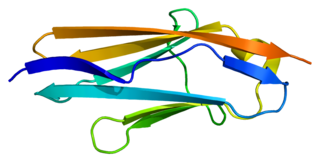Dynamin-2 is a protein that in humans is encoded by the DNM2 gene. [5] [6]
Dynamin-2 is a protein that in humans is encoded by the DNM2 gene. [5] [6]
Dynamins represent one of the subfamilies of GTP-binding proteins. These proteins share considerable sequence similarity over the N-terminal portion of the molecule, which contains the GTPase domain. Dynamins are associated with microtubules. They have been implicated in cell processes such as endocytosis and cell motility, and in alterations of the membrane that accompany certain activities such as bone resorption by osteoclasts. Dynamins bind many proteins that bind actin and other cytoskeletal proteins. Dynamins can also self-assemble, a process that stimulates GTPase activity. Four alternatively spliced transcripts encoding different proteins have been described. Additional alternatively spliced transcripts may exist, but their full-length nature has not been determined. [7]
DNM2 has been shown to interact with:
Mutations in this gene have been associated to cases of acute lymphoblastic leukaemia, [10] or congenital myopathy (centronuclear type). [11]

Cortactin is a monomeric protein located in the cytoplasm of cells that can be activated by external stimuli to promote polymerization and rearrangement of the actin cytoskeleton, especially the actin cortex around the cellular periphery. It is present in all cell types. When activated, it will recruit Arp2/3 complex proteins to existing actin microfilaments, facilitating and stabilizing nucleation sites for actin branching. Cortactin is important in promoting lamellipodia formation, invadopodia formation, cell migration, and endocytosis.

Myc box-dependent-interacting protein 1, also known as Bridging Integrator-1 and Amphiphysin-2 is a protein that in humans is encoded by the BIN1 gene.

AP-2 complex subunit alpha-1 is a protein that in humans is encoded by the AP2A1 gene.

The alpha-1B adrenergic receptor (α1B-adrenoreceptor), also known as ADRA1B, is an alpha-1 adrenergic receptor, and also denotes the human gene encoding it. The crystal structure of the α1B-adrenergic receptor has been determined in complex with the inverse agonist (+)-cyclazosin.

Dynamin-1 is a protein that in humans is encoded by the DNM1 gene.

Alpha-actinin-4 is a protein that in humans is encoded by the ACTN4 gene.

Endophilin-A1 is a protein that in humans is encoded by the SH3GL2 gene.

Formin-binding protein 1 is a protein that in humans is encoded by the FNBP1 gene.

Chloride intracellular channel 4, also known as CLIC4,p644H1,HuH1, is a eukaryotic gene.

Ena/VASP-like protein is a member of the Ena/VASP family of proteins that in humans is encoded by the EVL gene.

Sorting nexin-9 is a protein that in humans is encoded by the SNX9 gene.

Dynamin-3 is a protein that in humans is encoded by the DNM3 gene. The protein encoded by this gene is a member of the dynamin family which possess mechanochemical properties involved in actin-membrane processes, predominantly in membrane budding. DNM3 is upregulated in Sézary's syndrome.

Rnd2 is a small signaling G protein, and is a member of the Rnd subgroup of the Rho family of GTPases. It is encoded by the gene RND2.

Formin-binding protein 1-like is a protein that in humans is encoded by the FNBP1L gene.

Striated muscle preferentially expressed protein kinase, in the human is encoded by the SPEG gene, a member of the myosin light chain kinase protein family. SPEG is involved in the development of the muscle cell cytoskeleton, and the expression of this gene has important roles in the development of skeletal muscles, and their maintenance and function. Mutations are associated with centronuclear myopathies a group of congenital disorders where the cell nuclei are abnormally centrally placed.

Peroxisomal membrane protein 11B is a protein that in humans is encoded by the PEX11B gene. It is involved in the regulation of peroxisome abundance.

FYVE, RhoGEF and PH domain-containing protein 4 is a protein encoded in humans by the FGD4 gene.

GTPase activating protein and VPS9 domains 1, also known as GAPVD1, Gapex-5 and RME-6 is a protein which in humans is encoded by the GAPVD1 gene.

Chloride intracellular channel protein 3 is a protein that in humans is encoded by the CLIC3 gene. This protein is a chloride channel.

The Rho GTPase activating protein 31 is encoded in humans by the ARHGAP31 gene. It is a Cdc42/Rac1 GTPase regulator.